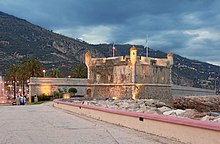Menton
![]()
This article describes the French city. For the lowest point of the lower jaw, see craniometry.
Menton [mɑ̃ˈtõ] (Italian Mentone [menˈtoː.ne]) is a French commune, also a town, with 30,231 inhabitants (as of 1 January 2018) in the Alpes-Maritimes department in the Provence-Alpes-Côte d'Azur region.
Menton is located on the Côte d'Azur (French Riviera), part of the French Mediterranean coast. The municipality is located on the border with Italy opposite Ventimiglia. Menton is the first French town after the Italian border and thus the first or easternmost French town on the Côte d'Azur.
The local dialect is Mentonasque or Mentonnais. The place name Menton is pronounced Mentonasque [meⁿˈtaⁿ]. In Menton, the place name is spelled Mentan (in Occitan: Menton in the classical norm or Mentan in the norm of Frédéric Mistral). The inhabitants are called Mentonnais or Mentonasques.

Bastion (Musée Jean Cocteau)

Former French-Italian border post in Menton (the municipality of Ventimiglia on the right)

View of the old town of Menton
Location and climate
Protected by the foothills of the Maritime Alps in the hinterland, Menton is characterized by a particularly mild climate (Mediterranean climate).Due to its sheltered location, Menton is the warmest place on the French Côte d'Azur in winter. The most pleasant months to travel are May and mid-September to mid-October. The rainiest months are February and March. In general, the temperatures are a few degrees above the temperatures in Germany. The months of June to August can be very hot. However, many events and exhibitions take place in August, the holiday month of the French and Italians. Winters are mild, there is hardly any frost in Menton, snow falls about once every ten years.
History
In Roman times, the bay of Menton was called Pacis Sinus ("peaceful bay"), but nothing is known about a settlement from that time.
Until 1146, the town was owned by the Counts of Ventimiglia. After that, Menton was under the rule of the commune of Genoa or the Genoese Vento family, until 1346, when it came, together with Roquebrune, to the Grimaldi of Monaco.
The Monegasque rule lasted until 1848, the same year the town of Menton and Roquebrune rose up against the taxes demanded by Monaco and proclaimed an independent republic. The French emperor Napoleon III then intervened and bought Menton from the Monegasque princely house.
In 1861, the inhabitants of Menton voted to become part of France. At the end of the 19th century, tourism began. The climate on the Côte d'Azur was recommended by doctors at the time as being conducive to curing tuberculosis. This is why this city was a popular winter quarter for British and Russians in the 19th century. Among others, the British Queen Victoria stayed here during her winter holidays. Even today you can admire the large hotels and gardens that were built for the English at that time, as well as an Orthodox church.
In 1872, the town was connected to the railway network via the Marseille-Ventimiglia railway line. During the First World War, many wounded soldiers also stayed in Menton for convalescence.
On 28 January 1939, the Irish poet William Butler Yeats died in Menton. Menton was quickly occupied by the Italians in World War II with the surrender of France, and by the Germans in 1943 after the surrender of Italy, from whom it was taken in 1944 under heavy fighting. Menton lay in ruins and it took until the mid-1960s for the town to be rebuilt. Since then, tourism in Menton has continued to develop vigorously. With the increasing mobility of the wealthy population of northern Italy, Menton is gradually coming back under Italian influence. Since the abolition of border controls and the introduction of the Euro as currency, many Italian citizens find a new home here.
Population development
| Number of inhabitants | ||||||||
| Year | 1962 | 1968 | 1975 | 1982 | 1990 | 1999 | 2006 | 2016 |
| Inhabitants | 19.904 | 25.040 | 25.143 | 25.086 | 29.141 | 28.812 | 27.655 | 28.486 |
Search within the encyclopedia